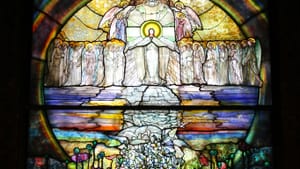Stay in the Loop
BSR publishes on a weekly schedule, with an email newsletter every Wednesday and Thursday morning. There’s no paywall, and subscribing is always free.
Monuments and landscapes
A James Garfield themed road trip

When I mentioned to a friend I’d be embarking on a road trip that would take me through northern Ohio, he suggested stopping by the James A. Garfield Memorial in Cleveland, resting place of the 20th president of the United States. Then I discovered the existence of a lesser-known memorial to President Garfield, located in Philadelphia’s Fairmount Park.
Before departing, I went to look for the stone and bronze monument. It can be found in a grassy space on the east side of Kelly Drive, barely south of the Girard Avenue Bridge. One of 50-some sites included in the city’s Museum Without Walls, the Memorial is an elegant 1895 work by American sculptor Augustus Saint-Gaudens. While President Garfield appears in bust form on top of the monument, the main attraction is a bronze statue of a classical figure dressed in the folds of a flowing garment. Her face is lovely. Her look is kind and genuine. She represents America or the Republic and holds a down-turned sword. I recommend paying her a visit.
It’s helpful, even if doleful, to remember James Garfield as one of four assassinated U.S. presidents. He had served 200 days in office before being halted in the year 1881 by a vainglorious man with a gun. The man’s name was Charles Guiteau; and in addition to appearing among the cast of characters of Stephen Sondheim’s Assassins, part of his unfortunate brain is on display in the Mütter Museum at the College of Physicians of Philadelphia.
 After departing home and driving across Pennsylvania and a stretch of Ohio, I arrived at the Lake View Cemetery in Cleveland, where the James Garfield Memorial was erected in 1890. It is a noble edifice made of Ohio sandstone darkened by age. Essentially a mausoleum and religious in feeling, the monument dominates the highest knoll of the cemetery. One can walk inside. The interior features a 12-foot tall statue of President Garfield, constructed of the white Carrara marble honored by Michelangelo.
After departing home and driving across Pennsylvania and a stretch of Ohio, I arrived at the Lake View Cemetery in Cleveland, where the James Garfield Memorial was erected in 1890. It is a noble edifice made of Ohio sandstone darkened by age. Essentially a mausoleum and religious in feeling, the monument dominates the highest knoll of the cemetery. One can walk inside. The interior features a 12-foot tall statue of President Garfield, constructed of the white Carrara marble honored by Michelangelo.
Fifteen stained-glass windows color the walls, one for each of the 13 colonies, plus Ohio (where Garfield was born) and, finally, a window shared by War and Peace: Garfield had been a soldier and a teacher. Atop the mausoleum, an ornate dome lifts the monument to a total height of 180 feet. An observation deck surrounds the dome, offering a five-mile view to the southern shore of Lake Erie — unless the sky is murky.
An exhibit at the site contends that if Garfield had been shot today, he would have survived. That is likely so. He did in fact remain alive and conscious for 11 weeks post-shooting and then succumbed to complications from accelerating sepsis. His was an age before the sterilization of medical instruments.
The Lake View Cemetery is itself a glory of trees, gardens, lanes, glimmering water, and boundless vistas of sculptured marble and stone. The prize of its architectural treasures, just downhill from Garfield’s tomb, is the Wade Memorial Chapel, deceptively stark in its columned neoclassic exterior. But enter through giant bronze doors, each said to weigh two tons, and come upon a revelation: a stained-glass window designed by Louis Comfort Tiffany, artistic son of the Tiffany founder.
The work depicts an angelic resurrection scene fashioned with layers of iridescent and translucent pieces of glass — altogether creating the full, rich, deep and unmistakable purples, roses, greens, yellows, and pinkish-whites of Tiffany. As the story goes, according to a cemetery attendant, Mr. Tiffany appeared at the chapel dedication in 1901, viewed the artwork for 10 minutes, said “I am perfectly satisfied,” and left for New York. (Side note of interest: Louis Tiffany took his primary schooling in West Chester, PA.)
Westward ho!
From the Botanical Garden in downtown Cleveland, I drove west through the three “I” states, crossing the mighty muddy Mississippi between Illinois and Iowa, and eventually entering Nebraska. There were scenery stops to interrupt the miles, including botanic gardens in Davenport and Des Moines.
When considering Nebraska, one thinks of the stories of Willa Cather and the hardship of windswept life on the Great Plains. One thinks of the prairie landscape but not of visual art. Yet Nebraska has been cultivating an artistic heritage. I visited the Museum of Nebraska Art (MONA), founded in 1976 and housed in a stately, white limestone colonnaded building that formerly served as the post office. There I enjoyed oil paintings of the big Nebraska sky coming down to meet the land. Most famous in the museum’s collection is the work of Robert Henri, born in Ohio in 1865 and raised in Nebraska before studying at the Pennsylvania Academy of Fine Arts in Philadelphia. Going on from the year 1900 to head the Ashcan School of American realism, Henri is particularly appreciated for his portraits of fellow artists. On view at MONA is his luminous depiction of a bride in her wedding gown.
Crossing from Nebraska to Colorado, everything changes, and then the earth rises up. Who can forget their first time seeing the range of the Rocky Mountains in the distance? Colorado was my destination, and it never fails to catch my breath and make me sing. Northeast of Fort Collins, driving straight into the Rockies, the hills rise so high it feels like you could bump your head on a cloud. Veer around a bend and the landscape moves beyond picturesque. With rocketing red cliffs and massive boulders as rounded as melons, it’s no longer a matter of wishing to look at a sculpture or painting; it’s the joy of entering a sculpture or painting.
Above right: Garfield Monument, Lake View Cemetery, Cleveland, Ohio. Photo by GandZ, via Wikimedia/Creative Commons
To read about another of Joanna Rotté's art-lover road trips, click here.
Sign up for our newsletter
All of the week's new articles, all in one place. Sign up for the free weekly BSR newsletters, and don't miss a conversation.

 Joanna Rotté
Joanna Rotté